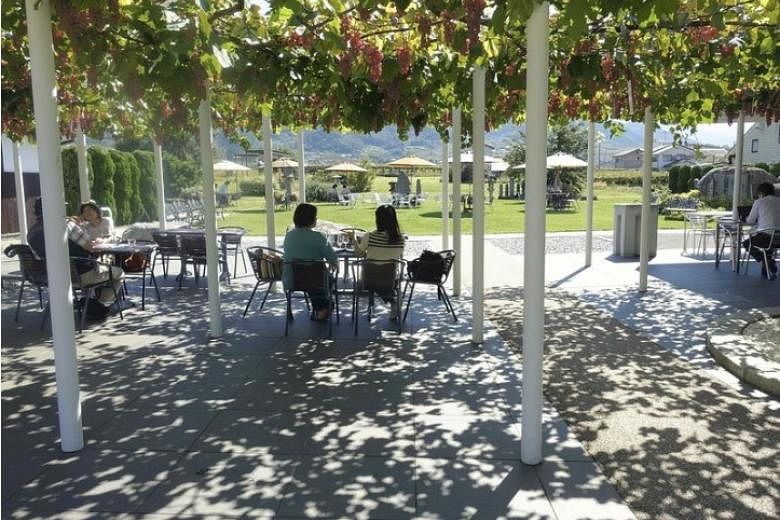KATSUNUMA (YOMIURI SHINBUN/ASIA NEWS NETWORK) - Can Japanese wine really taste this good?
The surprise I got when sipping a glass prompted me to schedule a trip to the Katsunuma region in Yamanashi Prefecture. The Showa era (1926 to 1989) cliche that "Japanese wine is sub-par" seems to be a thing of the past.
This year marks the 140th anniversary of the birth of the Japanese wine industry. The Katsunuma region in the Yamanashi city of Koshu is where it all began.
The areas that wineries dot are usually accessible only by car, meaning whoever drives cannot drink. But Katsunuma is free from such problems - it takes just 10 minutes by taxi from JR Katsunuma Budokyo Station to reach Miyakoen, a facility from where visitors can stroll around many of the about 30 wineries scattered across the area.
Dainihon Yamanashi Wine Company, founded in 1877 in Katsunuma, was Japan's first wine-maker. After the company dissolved in 1886, Kotaro Miyazaki took control of its equipment and built a winery at home, as well as a vineyard targeting tourists. These were collectively called Miyakoen.
The premises were later donated to the Koshu city government and have been open to the public since 2011 as a museum showcasing the wine-making industry in the nation before World War II. The precious visual archives and exhibits help visitors learn about the history of the Japanese wine industry.

Bottles of the highest quality
Chateau Mercian, located near the museum, is a winery that carries on the traditions of miyakoen. Every year, 100,000 people sign up for a tour at Chateau Mercian, which offers three types of winery tours.
I took the basic tour, in which I watched a video about fermenting, learnt how to taste wine properly and visited the vineyard.
Having become more accustomed to wine on the tour, I ordered a taster set of wines, which was not included in the tour.
I chose to sit at a table outside (there are indoor tables with views too) to enjoy the fresh air - with a panoramic view of the green grass and a mountain range spreading out beyond the grapevine trellises.
I tasted a set of the finest bottles at this winery while enjoying the stunning view. Each bottle costs around 10,000 yen (S$121), but you only need to pay 1,800 yen for the three-set sample. The wines were of the highest class.
"Japanese wine has gradually evolved since the 1970s and is now world-class," said tour winery guide Takashi Watanabe, 54, who is also the head of a visitor centre.
From next October, a new national rule will take effect - wine made with 100 per cent domestic grapes can be labelled "Japanese wine".
Japanese wines boasting flavours unique to the nation and their regions are expected to garner more attention.
Inspired by a fairy tale
Kurambon Wine Co, located nearby, was established in 1913. The main building was built more than 130 years ago as a silk farmer's house, but was later relocated and repurposed as a wine-tasting space and reference room. The wines you can taste in the Japanese-style house have a mild flavour that goes well with washoku Japanese food.
"I want to express (the region's) climate through wine," said Mr Takahiko Nozawa, Kurambon's fourth-generation owner.
Mr Nozawa learnt wine-making in France and drastically changed the way his company ferments grapes. In around 2000, the taste of Kurambon wine shifted from sweet to dry. Since 2007, the company has introduced a natural cultivation method that is free from chemical pesticides.
The company used to be called Yamanashi Wine, but the name was changed to mark its 100th year of business. Kurambon is a made-up word from famed author Kenji Miyazawa's fairy tale, Yamanashi.
When asked about the name, Mr Nozawa said: "I wanted to evoke the co-existence of nature and humans." The 43-year-old wine-maker sympathises with the author's view that such a way of life should be respected.
Like Mr Nozawa, wine-makers across Japan are working to produce better wines. Much to my surprise, this was affirmed to me in Katsunuma.
How to get there

From Shinjuku Station, it takes about an hour on the Chuo line to reach Otsuki Station by express train. From there, ride a local Chuo line train for 25 minutes to Katsunuma Budokyo Station. Some express trains stop at this station during the sightseeing season.

